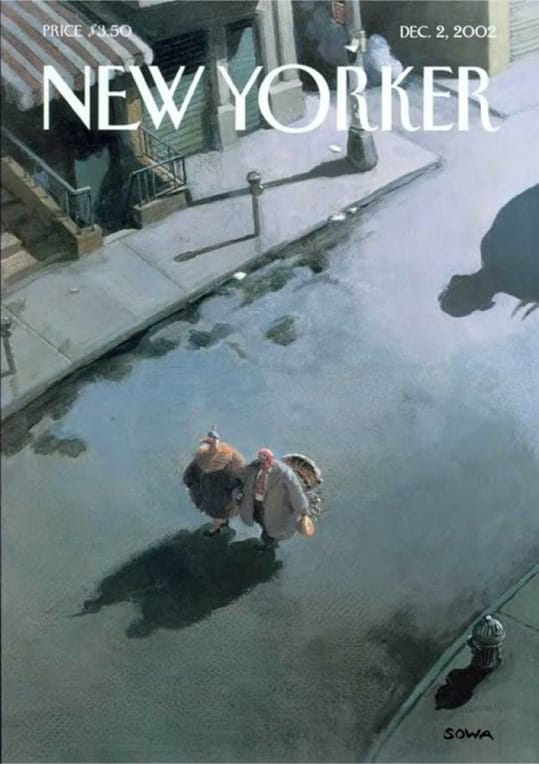Boat Magazine editor Erin Spens recalls how Michael Sowa’s illustration for The New Yorker’s 2 December 2002 cover eased her loneliness in a new metropolis. In 2002, when I moved to Manhattan, I was eighteen and a sharp note out of place in a city that has its own rhythm – one you can only move to after years of stepping on toes, falling down, and watching alone from the edges. I’d forced myself to stay for five months before visiting my family back in Iowa for Christmas that year, which meant I’d be spending my first Thanksgiving away from them and my first major holiday alone in New York. I grew over time to love the melancholy that comes with anonymity in a big city, but as a sprightly teenager from the friendliest part of America, that feeling was terrifying.
While everyone else in my universe was sitting around dinner tables eating and talking and laughing, I saw this cover of The New Yorker, a magazine I was of course aware of but not yet the die-hard fan I am today. It looked exactly the way I felt. I bought it, of course, curious if its guts would read to me as personally as the cover did.
Alone in the all-girl dormitory in Midtown where I lived, I opened it up and devoured it as you do if you love great writing. It contained one of my (still) favourite essays, in which the legend Gay Talese revisits some of the builders of the Verrazano Bridge who, 40-years on from its completion, were renovating it.
Talese writes, “After arriving at the top of the tower – a journey that took twenty minutes – he leaned out into the sky and went to work with wire brushes and scrapers to remove rust, and then, wearing rubber gloves, to smear a rust-resistant paste onto whatever corrosion existed along the flat surface and bolts of the tower. As he did this, he envisaged himself thirty years earlier, inserting these same bolts into the same steel, and once more he felt a sense of identity with the great structure. Tears came to his eyes, and, dipping his gloved left hand into a bucket of reddish paste, he reached out to touch an untarnished plate of steel which was secured by a row of bolts and, with his bent middle finger, he wrote as clearly as he could, in block letters, ‘Catherine’ – the name of his wife of thirty years, who had recently died of cancer.”
I don’t remember if that bit of the essay choked me up the first time I read it, but it does every time I read it now. It no doubt made me want to feel that sort of connection to a city where at the time I felt so foreign, like a turkey walking down the street. Now, as the editor of my own magazine, which is all about place and belonging, I hope I can recreate in others a sliver of that feeling I felt when I found this issue. That’s the magic of The New Yorker’s famously illustrated covers: they connect on a personal level, hint at what’s inside, they make you smile and in a really amazing New York kind of way, they cheer you right on towards the next week, where you can pick up another one and be inspired all over again.
Verrazano Bridge
Connecting Fort Hamilton in Brooklyn and Fort Wadsworth in Staten Island, the double-decker Verrazano-Narrows Bridge was the longest suspension in the world when it opened in 1964. It’s the starting point for the New York Marathon, and features heavily in the film Saturday Night Fever, where it’s a potent symbol of disco-loving Tony Manero's ambitions to escape claustrophobic Bay Ridge. Manero’s gang also use its vertiginous cables as a high-risk jungle gym to impress their dates and break-up their monotonous lives, and it’s from those heights that reluctant father-to-be Bobby falls, or jumps, to his death from in the film’s climax.
Michael Sowa
Anthropomorphic creatures, like the turkeys featured in Last Minute Errand above, are a mainstay of German illustrator Michael Sowa’s work. From ice-skating cows to a lonely cockroach weeping at its friend’s grave, Sowa’s incongruous scenarios are packed with humour but also show painstaking attention to detail and Vermeer-like use of lighting and colour. Hull band The Beautiful South were big fans, choosing Sowa to illustrate two of their record sleeves, and in whimsical French film Amélie, two of Sowa’s paintings were animated to pass judgement of the protagonist’s sorry love life.
March 20, 2014 3 minutes read
Talking Turkey
Boat Magazine editor Erin Spens recalls how Michael Sowa’s illustration for The New Yorker’s 2 December 2002 cover eased her loneliness in a new metropolis.

